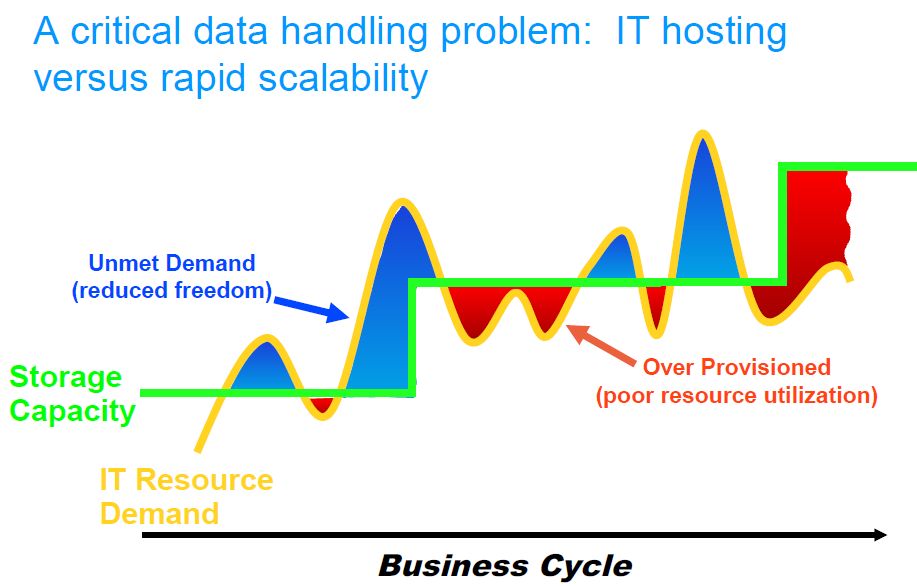Make digital your plus one!
The human heart dynamically modulates its rate of contraction to meet physical demands and is capable of performance improvement through training. In contrast, organizations are significantly challenged by fluctuations in business cycles and ongoing innovation demands. Restructuring, mergers and acquisitions, franchise expansion, and inventory management are a few examples of scalable business adaptations to changing demand. However, these changes often require significant time to take effect and organizations may feel trapped by delayed responses to infrastructure adjustments. Similarly, investments in digital technology may restrain organizational performance as big ideas are limited by under-provisioning and small ideas fail to reap the advantages of digital resource abundance.
Digital scalability
Digital technology supports innovation processes that drive future business potential. However, organizational capabilities often present as a rate limiting factor in digital freedom. First, senior management, including the CTO and the CIO, must promote an entrepreneurial culture that favors learning through experimentation and open boundaries for idea exchange. Employees require job security and protected time for reflection as innovative projects evolve through iterations. Second, organizations should continue to invest in technology and leverage complementary assets to favor digital integration. Ideally, investments for projects that are critical to success are relatively minor with short R&D cycles. Otherwise, the project may be considered discretionary or potentially outsourced. Third, organizations should consider technology scalability in order to minimize wasted resources due to over- and under-provisioning and down time; the latter two factors being major recent shortcomings of the Obamacare website. Indeed, social media owes much of its success to the 99.999% up-time of the secure servers that protect the reputation of various media outlets. Fourth, digital must be equally accessible internally. This would require multiple site licenses ("That database is only available on this computer."), equal infrastructure per employee ("Why should I work with one monitor when you have three?"), and well controlled BYOD (bring your own device) policies to maximize knowledge sharing and minimize conflicts. Finally, digital freedom must be protected by secure technology infrastructure. The Great Firewall of China or Golden Shield is a controversial example of government intervention to protect national security, maintain social order, and reduce illegal activity. Similarly, Blackberry encryption services offer significant advantages for secure global enterprise communications.
Cloud computing including infrastructure and software services may prove to be the ideal digital cross functional team player in terms of rapid scalability and security. Business opportunities in cloud computing include: 1) reduced capital expenditures and IT maintenance costs, 2) improved data exchanges, 3) rapid modification of business processes, 4) process uniformity across geographic regions and 5) the development of products, services, and engagement processes that were not previously possible. Challenges associated with cloud computing are: 1) integration difficulties due to inertia, 2) loss of IT ownership, 3) cannibalization of legacy IT infrastructure investments, 4) lock-in vendor contracts and service agreements and, 5) reliability, privacy, and confidentiality requirements.
Information intensity and action
Digital freedom is readily achieved when technology is applied in dedicated spaces where immediate actions are required over a defined period such as operating rooms, sports arenas, manufacturing lines, air traffic control towers, and restaurant kitchens. In these “in the zone” environments, digital technology is business critical and project limited. The granular data generated in well-defined settings favors control while minimizing assumptions for effective decision making. In contrast, digital freedom appears to be less attainable in larger spaces where rapid and accurate responses are either less in demand, difficult to obtain due to data volume, or not feasible such as in mining and forestry operations, agriculture, consumer goods, and educational settings. In these contexts, technology generally plays either a supporting role or serves as a vital component of strategic transformation. However, while a sense of digital autonomy may be greater when operating “in the field”, the individual level of accountability based upon data may be diluted. By favoring connection, contribution, creation, challenge, and choice within organizations, scalable digital offered by cloud computing is expected to increase agency as employees are free to engage and act.
Does digital satisfy unmet needs?
Moore’s law states that processing power doubles every two years. Although the value of utility derived from a one unit increase in processing capacity is difficult to determine, a corresponding marginal increase in user performance does not appear be evident. Common arguments in favor of technology upgrades include greater agility, faster responses, as well as improved connectivity and information exchange. However, for the common user, such gains in performance are incremental at best making advanced processors primarily a symbol of tech horsepower on the digital highway. Therefore, the degree of digital provisioning and level of tech scalability are critical factors to minimize confinement and restraint (Figure 1). In addition, to determine the gain in independence offered by digital, one must look beyond speed, efficiency, and functionality of hardware and software and carefully consider indirect agency benefits for stakeholders. For example, questions worth carefully considering may include:
Does digital reduce infrastructure demand and help businesses to focus on other tasks?
Does digital enable project completion on time, on task, and on budget?
Does digital allow the user to accurately detect danger and minimize the associated risks?
Does digital facilitate inquiry and the transfer of knowledge?
Does digital provide actionable insights that could not be attained otherwise?
Does digital favor the development of unique strategic assets?
Does digital permit employees to work remotely and reach farther geographically?
Recognizing digital dependencies
Humans have a strong need to communicate; to speak on the phone, to correspond by mail, to store and exchange information, to coordinate activities, to explore, and so on. Although digital technology is generally considered an enabling advancement, perhaps it is more so human social behavior that empowers technology. Quite subtly, humans relinquish significant control once they adopt elegantly designed digital devices that stimulate their senses of sight and sound. Gradually, growing personal digital dependencies contribute to difficulties recalling phone numbers, calculating gratuity, remembering important dates, and finding directions. In the unfortunate event of a forgotten password, one is temporarily unable to login and manage their finances, business engagements, or their digital brand. Moreover, the consequences of a damaged, lost, or stolen digital device can be devastating. Consequently, periodic data backups, mnemonic aids, limited password changes, and alternate power sources are required as contingencies to ensure digital up-time.
Organic: 100% technology free?
Is a perceived loss of rights due to digital per se or is liberty compromised by increasing human dependence on digital? A prescription for a digital “detox” might allow one to quickly determine the source of digital constraints. Untethering the digital umbilical cord results in a return to bare basics. By simplifying and eliminating technology restraints, one may gain insights into personal capabilities that lead to improvements in both soft and hard skills; such as reading body language during face to face communications and estimating market share on a dry erase board. More importantly, one may begin to define the true value added by technology investments. Is the investment in technology really necessary? On a larger scale, how would entire enterprises perform without legacy systems, cloud computing, Big data, Agile, Scrum, Kanban, real time analytics? Except for a profound reliance on software and hardware, a loss of freedom to connect, contribute, choose, create and challenge does not appear to be digitally imposed.
Digital sidekicks
Recently, a functional neuroimaging study has determined that the insular region of the brain associated with love also become active at the sight of a smartphone. Though various stimuli activate neurons in this region of cerebral cortex, the finding is not that surprising considering that individuals often assign a name to their car, boat, or even their digital server. In addition, technology terms and company names have become integrated into our vocabulary as Googled, e-mailed, faxed, Xeroxed, and Skyped. Indeed, digital devices and technologies have a tendency to become a household item (i.e., Siri, voice navigators, and automated phone systems) or a sidekick such as R2D2, C3PO and Watson, the Jeopardy champion with four terabytes of storage. By serving human needs effectively, digital becomes an invaluable extra element on the competitive field. For example, digital has a significant impact in the operating room through surgical simulations that improve the outcome of complex procedures, repeated noninvasive imaging to verify complete tumor resection, real time monitoring and control of the surgical depth of anesthesia, and other medical processes that demand immediate responses. Similarly, sports competitors, coaches, and officials depend upon image analysis to improve technique and athletic form, to confirm inbound play, and to verify race timing and point scoring. Thus, integrated digital technologies offer users freedom when relevant information is rapidly and clearly exchanged to inform strategic action.
Balanced Digital
Striking an optimal work-life balance is always a signficant challenge. Likewise, managing a healthy digital organization can be just as difficult when data are inaccessible, insufficient, incorrect, or mired in fatty clutter. Acting as a pacemaker, digital is a vital component of an organization. Just as millions of caridac cells contract in response to electrical impulses to pump blood throughout the body according to demand, teams must train and work together with digital to succeed.




You need to register in order to submit a comment.